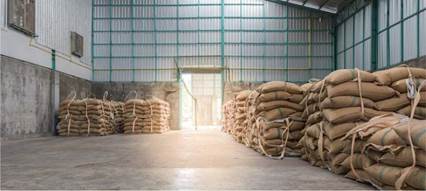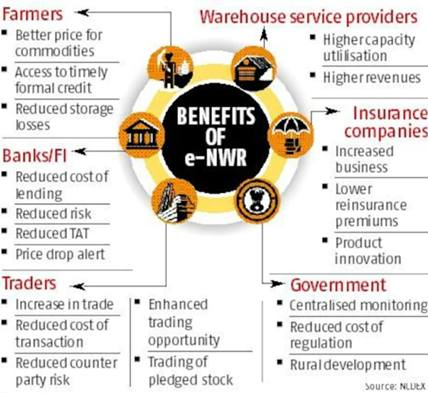Description

Disclaimer: Copyright infringement not intended.
Context
- Warehousing and Electronic Negotiable Warehouse Receipt (e-NWR) are going to play a critical role in the transformation of India and rural India in particular --- Department of Food and Public Distribution (DFPD).
- The Secretary of DFPD was addressing a seminar on “e-NWR – An Effective Tool for Promoting Pledge Financing” organized by the Warehousing Development and Regulatory Authority (WDRA).
Warehousing Development and Regulatory Authority
- The Warehousing Development and Regulatory Authority (WDRA) was set up by the Government of India in 2010 to ensure the implementation of the provisions of the Warehousing (Development & Regulation) Act, of 2007.
- The main objective of WDRA is to implement a Negotiable Warehouse Receipt (NWR) System in the country, which would help farmers to store their produce in scientific storage godowns near their farms and to seek a loan from banks against their NWR.
- The main functions of the Authority are to make provisions for the development and regulation of warehouses. These include the negotiability of warehouse receipts, registration of warehouses, promotion of scientific warehousing of goods, improving fiduciary trust of depositors and banks, enhancing liquidity in rural areas, and promoting an efficient supply chain.
Negotiable Warehouse Receipt (NWR) System
- WDRA implements a Negotiable Warehouse Receipt (NWR) system in India so that farmers (as well as businesses) are encouraged not to sell their produce immediately after harvest when prices tend to be the lowest in the year.
- They can store their produce in WDRA-registered warehouses that have to issue NWR to them. The farmers can seek loans from banks against their NWR. The WDRA regulates the negotiability of warehouse receipts so as to improve the trust of depositors and banks in the newly evolving ecosystem.
- The rules for registration of warehouses were notified by the WDRA in 2010. It then revised the rules in 2017 and prescribed the minimum financial, legal, and infrastructure requirements for the registration of warehouses with the WDRA.
- So far, the WDRA has notified 123 agricultural commodities and 26 horticultural commodities for which the warehouses can issue e-NWRs.
- From October 2010 to July 2019, the registered warehouses were required to issue physical NWRs. These receipts were printed in the government’s security printing press.
- From November 2017, the applications for registration of warehouses with the WDRA were to be submitted only in online mode. In August 2019, the WDRA issued a notification that made it mandatory for registered warehouses to issue negotiable warehouse receipts only in electronic form, that is, an e-NWR.

Electronic Negotiable Warehouse Receipt (e-NWR)
- Warehousing Development and Regulatory Authority (WDRA) launched the web portal “Electronic Negotiable Warehouse Receipt (e-NWR) System” in 2017.
- The web portal was launched for simplifying the Warehouse Registration Rules, digitizing the entire process of registration, monitoring, and surveillance as well as the creation and management of Negotiable Warehouse Receipts (NWRs) in electronic form.
- The e-NWRs are recorded and maintained in digital form by two repositories approved by the WDRA. These are the National E-Repository Limited and CDSL Commodity Repository Limited. This was an important decision to formalize the agricultural economy.
- The e-NWRs would have no chances of any tempering, mutilation, fudging, loss or damage and with no possibility of any multiple financing. Hence, these NWRs will not only facilitate easy pledge financing by banks and other financial institutions but also smooth trading on various trading centers like commodity exchanges, electronic National Agriculture Markets (e-NAM), and other electronic platforms.

Gaps in the warehouse system
- From January 2019, the settlement of derivative contracts of agricultural commodities became compulsory through e-NWRs only.
- However, formalization has met only limited success so far and most of India’s agricultural produce is still stored in unregistered warehouses. There are only 1,982 warehouses (including 93 inactive ones) registered with the WDRA, as of 2021.
- Private warehouse owners are reluctant to register their warehouses with the WDRA because they feel that regular audit and inspection by the body will restrict their operations and they may lose income from collateral management fees they earn from the banks.
- The banks continue to extend loans against warehouse receipts issued by unregistered warehouses. Moreover, the banks are not yet confident that the WDRA has adequate staff to supervise the management of registered warehouses, which can ensure the quality and quantity of stored agricultural produce. [Note: Since 2018, WDRA is functioning without a regular chairperson and with just two members while the Act provisions a three-member body]
Moving Forward
- Since the largest stock of food grains is held by the Food Corporation of India (FCI) and NAFED on behalf of the government, it can use e-NWRs to monitor the stocks. The FCI can use e-NWRs to sell wheat and rice in the open market under the open market sale scheme. Similarly, NAFED can use it for the sale of pulses and oilseeds by just transferring the e-NWRs.
- The Government should make registration with the WDRA mandatory for all warehouses with storage above 2,000 tonnes so that over the next three years, they are upgraded by the owners to meet the scientific standards prescribed by the WDRA.
- Simultaneously, the WDRA must be allocated the required human and financial resources to supervise the registered warehouses so that the banks can reduce their dependence on collateral managers.
- So far, it is generally the traders who store the produce in warehouses and participate in commodity futures markets. The farmer-producer organizations need support and guidance from the government to store the produce after harvest so that the farmers can also gain from the off-season increase in prices.
https://pib.gov.in/PressReleaseIframePage.aspx?PRID=1872423










